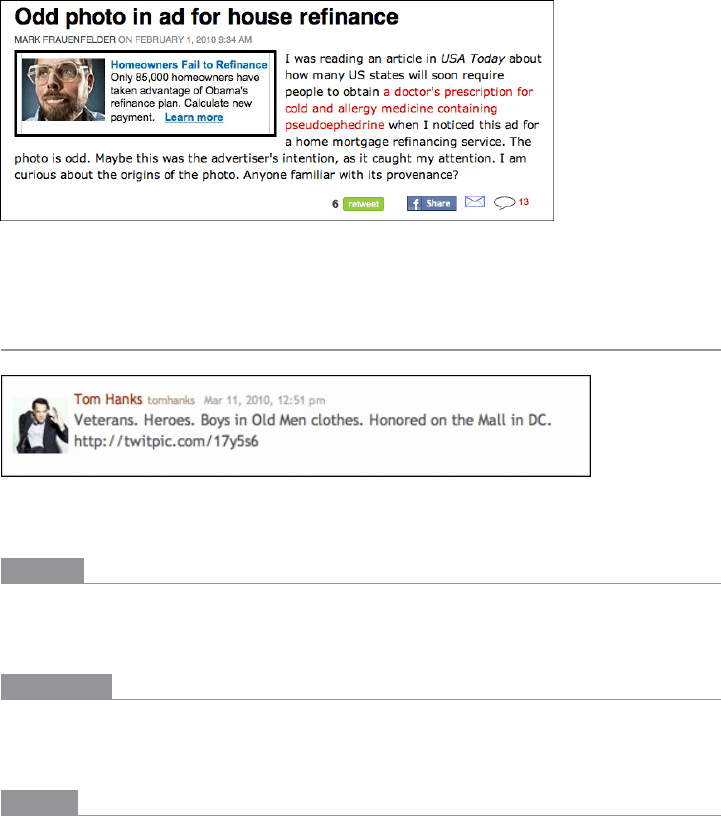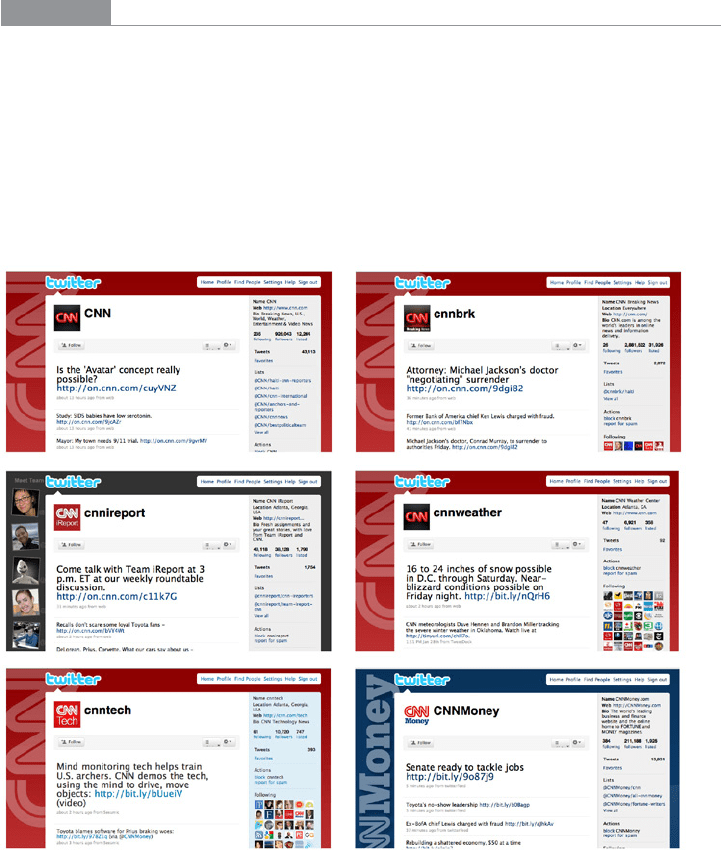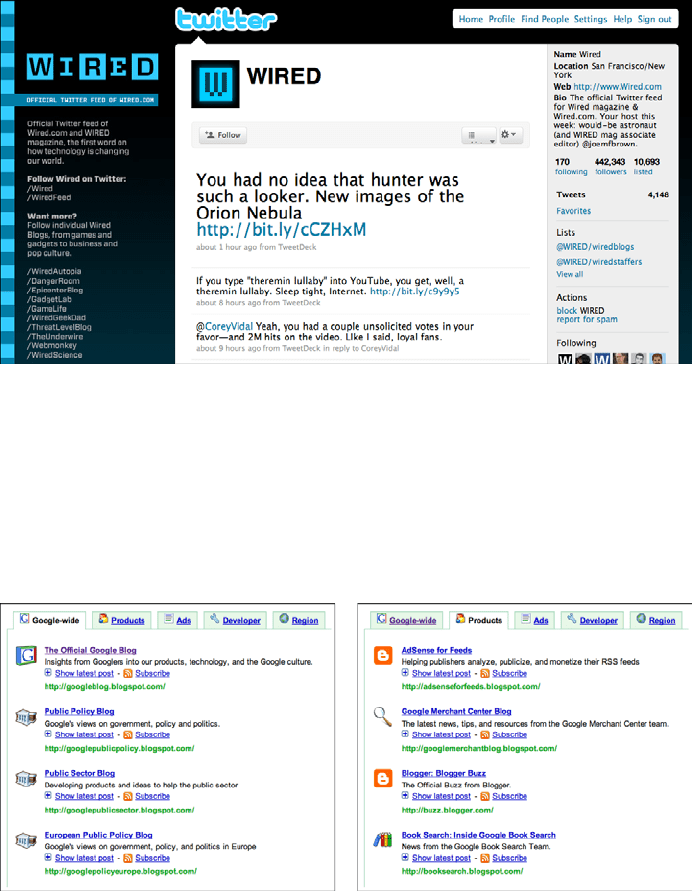Tidwell J. Designing Interfaces (Second Edition)
Подождите немного. Документ загружается.


The Patterns 413
Blogs such as Boing Boing have very talkative readers. In Figure 9-15, one of the bloggers
poses an open-ended question to the readership.
Figure 9-15.
Boing Boing’s conversation starter
Inverted Nano-pyramid
Figure 9-16.
Short but informative tweet
What
Write short, dense status updates and headlines. The first few words are most important;
they should catch the interest of the right readers, and transmit the most information.
Use when
You post updates to Twitter, Facebook, or other microblogging channels, or you write
headlines for blog posts and articles.
Why
People skim updates and headlines quickly, to determine what’s worth their attention.
Take full advantage of the small amount of space and time you have.
Long tweets, status updates, and so on can’t be quoted or retweeted as effectively as short
ones. You want followers to repost your updates and get your name out there in front of
more people.

414 Chapter 9: Using Social Media
How
Traditionally, print journalists have used the “inverted pyramid” for news reporting. The
most important information is front-loaded into the first sentence and paragraph of a
story. Secondary information comes next, and so on until the least important informa-
tion ends up at the bottom. Since many readers won’t go any farther than the first few
sentences, you should give them the essence of the story right at the beginning.
Twitter’s ruthlessly low character limit forced us to learn how to write in a very short
format. Every word counts; every character counts. So use the pyramid form—the most
important points in front—but shrink your messages down to the size of a tweet or status
update! Here are some ways to write them well:
• Choose words that accurately represent the topic and scope of what you’re talking about.
Use words that are specific, not general; make each word carry its weight. To help focus
your thinking, consider whether people will understand you if your tweet or headline is
taken completely out of context (as though it were a search result, for instance).
• Strip out words that don’t carry their weight, especially linking words such as the and
have, but don’t be so cryptic that you can’t be understood.
• Use abbreviations sparingly; don’t sound like a text message written by a 10-year-old.
• Make one single point. If you need to make two points or describe two links, use two
tweets or status messages.
• If you use a long word, try to find a shorter substitute. But if the longer word has
character and specificity, you might choose to keep it to draw attention.
• For phrasing, consider using one of the eight types of headlines described in Robert
Bly’s The Copywriter’s Handbook (Holt Paperbacks). These are: direct, indirect,
news, how-to, question, command, reason why, and testimonial. For a good online
summary of these types, with examples, see Copyblogger’s summary at http://www.
copyblogger.com/how-to-write-headlines-that-work/.
• Be patient as you write. Short content requires more thought and iteration than you
might expect.
Examples
The tweets shown in Figure 9-17 tell ultra-short stories. You can’t help but read them.

The Patterns 415
Figure 9-17.
Ultra-short stories
The news headlines shown in Figure 9-18 were designed to tempt readers to click through
the link.
Figure 9-18.
News headlines designed to tempt readers to click through the link
As shown in Figure 9-19, the American Red Cross uses Facebook status messages and
links to both convey information and persuade the reader to learn more (links not shown).
Figure 9-19.
The American Red Cross’s Facebook status messages and links

416 Chapter 9: Using Social Media
Timing Strategy
Figure 9-20.
Possible social media timing for an organization
What
Pace your social media posts according to the expectations of the channels you use; some
channels require more frequent posts, some less. Cross-post the best pieces, and consider
when in the day or week you make your posts.
Use when
Anyone who uses social media should develop and follow a Timing Strategy.
Why
Overusing a social media channel can overwhelm your followers with too much chatter.
Followers may drop you, or form a negative impression of your organization. Don’t irritate
people.
On the other hand, underusing a channel is an opportunity cost: you won’t have your
name in front of followers as often as you could.
Users of Twitter and Facebook in particular have expectations about how often they hear
from nonfriend entities (such as company pages) in their personal news stream. The
mechanisms of the channels themselves dictate some of this; tweets are shorter and more
rapidly consumed than Facebook updates, for instance. These expectations may change
as the technologies mature and shift.

The Patterns 417
How
The most important thing is to understand users’ expectations about these channels. If
you post too frequently, your updates clutter followers’ personal news streams to the point
of being annoying, and they may unsubscribe from you.
However, the advice here is only a starting point. You should watch the numbers of fol-
lowers change as you use social media, listen to followers’ feedback, and be willing to
adjust your timing strategy on the fly if followers leave.
As of this writing, here are some of the posting frequencies that I have observed.
Facebook pages tend to be updated only once per day, or less. Most of the successful and
active pages I studied had a post rate of roughly once every two days, though some had
two per day (such as Wired) and others had much fewer. Exceptions are sometimes made for
time-sensitive events, concentrated outreach efforts, and crises such as major earthquakes—
followers will tolerate short bursts of frequent posting if the cause is worthy. Your mileage
may vary.
Twitter posts can be much more frequent than Facebook updates. The organizations I
studied posted between three and 15 tweets per day, on average. Also, these posts were
usually made between noon and 8:00 p.m. Eastern Standard Time, with a lower rate on
weekends. This is important because tweets should go out when the most people are on-
line and listening—Twitter users (unlike Facebook users) tend not to scroll back through
time to find interesting material. Note that many tweets from some organizations are
direct replies to individuals; those can run up the count quickly.
For organizations that use multiple social media channels, blog posts range between 0.5
and 2.5 posts per day. This is where long-form writing takes place: essays, stories, in-
terviews, and other content longer than one or two sentences. Sometimes these blogs
“feed” the Facebook and Twitter efforts—selected blog entries (usually not all of them)
are reposted as links in these other media, along with a one-sentence description. Lively
conversations about the blog posts are more likely to take place on Facebook or Twitter
than on the blog itself.
Email should be infrequent. If you send email more than once every few days, you may get
labeled as spam by some of your followers.
I found no evidence of timing strategies for media repositories such as Flickr and YouTube.
This is probably because they don’t normally “push” content out into followers’ personal
news streams, as others do.

418 Chapter 9: Using Social Media
Examples
The chart in Figure 9-21 shows the timing strategies for several companies and organiza-
tions that have strong social media presences. The data was collected over two months at
the very beginning of 2010, in January and February. The numbers represent the average
number of posts per day on each of three social media channels: Twitter, Facebook, and
the organization’s main blog. (Not all of these sites had a main blog.) Clearly, the Twitter
numbers are higher than the others, reflecting its more ephemeral nature.
The last two companies, the American Red Cross and Partners in Health, are charities.
Over the time period that I collected data, these two organizations were conducting inten-
sive news and fundraising efforts related to the Haiti earthquake. Their usage of Facebook
skyrocketed in January, and then faded back to something more normal in February; this
shows up in the averages as slightly elevated Facebook numbers.
0
Dell
Whole Foods
Coca-Cola
Red Bull
Starbucks
REI
Volkswagen
American Red Cross
Partners in Health
2
4
6
8
10
12
Twitter
Facebook
Blog
14
16
Dell
Whole Foods
Coca-Cola
Red Bull
Starbucks
REI
Volkswagen
American Red Cross
Partners in Health
3
Twitter
14
10.5
5.3
10
3
2
3
2.7
0.3
Facebook
1
0.5
0.5
0.2
1
0.5
1.3
2.5
0.6
Blog
1.4
0.6
0.6
1
2.4
Figure 9-21.
Actual post rates for nine sites

The Patterns 419
Specialized Streams
Figure 9-22.
Wired blogs, specialized by topic
What
Divide your content stream into many different channels, each with a different readership
and different “feel.” Use multiple Twitter identities, Facebook pages, blogs, and so on to
steer these items to the right audiences.
Use when
Your organization generates a large number of status updates, news articles, blog posts, or
other items that are socially distributed. You can categorize them easily by subject or some
other factor (such as frequency or author). You have a large readership, but many readers
are only interested in one or two of these categories, not all of them.

420 Chapter 9: Using Social Media
Why
If you dump all of your organization’s updates into one huge stream, that stream might
overwhelm its followers. For instance, a Facebook page shouldn’t be updated many times
per day, lest its readers unsubscribe because of too many updates.
With several discrete streams or pages to follow, people can easily pick and choose among
the topics you offer, thus tailoring their own experience.
How
Categorize your updates according to your followers’ needs. Consider the following ways
to segment a readership, and see if any of them can work for you. (Not all will be suitable
for your organization, of course.)
By product
Do you sell different products to different types of customers, for instance? What
are the common needs and perspectives of a product’s users? For example, users of
smartphones will have one set of needs; users of desktop systems, quite another.
By topic
If you publish a lot of news articles or opinion pieces, how do you segment your mar-
ket according to subject?
By professional role
See the Google example in Figure 9-25; some of its blogs are aimed at a general audi-
ence, some at managers, and some at developers.
By social media usage style
How often do your followers read their news stream? Some people practically live on
Twitter; they may have a high tolerance for chatter. Other people will only want occa-
sional updates, and those updates had better be worth reading. CNN has several news
feeds that operate with different
Timing Strategies to serve these different markets; see
the example in Figure 9-23.
Within the social media services that you’ve chosen to use, create different channels or
streams. Each should be labeled clearly with your organization’s name and logo, and visu-
ally branded appropriately—there should be no question that this stream is an official part
of the organization’s social media strategy.
Direct people to those streams at the right points. Put links to them on your front page, or
from your main presence on the social media services. For instance, if your organization
has a main Facebook page, link to the
Specialized Streams from that page. If you spend ef-
fort to build them, you might as well tell people about them.
Consider using selected content from the
Specialized Streams—not all of it, of course—in
your main blog, Facebook page, or Twitter feed. Reference the
Specialized Stream from that
content so that interested readers can find it and subscribe.

The Patterns 421
Examples
Updates are CNN’s business, and it generates a lot of them. CNN has a main Twitter feed that
it updates every few hours with general-interest news stories, but as of this writing, “cnnbrk”
(for breaking news) has almost three times as many followers. “cnnireport” is CNN’s third
main Twitter stream, and the CNN site directs readers toward all three. However, for the
skilled and motivated Twitter user, there are even more streams to be found! Entertainment,
weather, technology, money, international news, and other topics all have their own special-
ized CNN Twitter feeds, though they’re not easy to find. Figure 9-23 shows some of CNN’s
Twitter feeds.
Figure 9-23.
Some of CNN’s Twitter feeds
Likewise, Wired divides its numerous updates into Twitter feeds that are specialized by
topic. Many of these primarily tweet links to posts in Wired’s corresponding blogs—see
Figure 9-22, which shows some of those blogs. One nice thing Wired does is post a long
list of specialized Twitter feeds in its background image, as shown in Figure 9-24. (Even
though they’re not clickable links, they still convey information.)

422 Chapter 9: Using Social Media
Figure 9-24.
Wired’s main Twitter feed, with Specialized Streams listed in the lefthand margin
Google has built many products, each of which has its own constituency (casual readers,
developers, domain experts, etc.). It also serves many regions of the world, and evokes in-
terest worldwide in many aspects of its operation. Google therefore sends out its updates
via a diverse set of corporate blogs (see Figure 9-25). Its main blog publishes general-
interest stories, but it sometimes runs entries that are cross-posted from a more specific
blog.
Figure 9-25.
Some of Google’s blogs
Microsoft has a vast number of social content streams on Facebook, Twitter, YouTube,
Flickr, MySpace, Delicious, forums, and blogs. Some are listed in Figure 9-26. They
are aimed at customers for particular products, in particular roles; some are very spe-
cialized, and some are general with very large audiences. (Credit for this table goes to
EngagementDB, at http://www.engagementdb.com/Company/77.)
